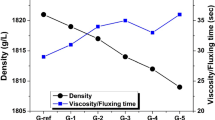Abstract
In ceramic tile manufacturing, α-Al2O3 is the main type of alumina used in ceramic body and glaze formulations. It acts as an opacifier in porcelain tile bodies and as a matting agent in glazes. White fused alumina (WFA) is produced by fusing calcined alumina in an electric arc furnace under carefully controlled conditions. It is generally preferred in ceramic floor tile glazes in order to increase abrasion resistance. The aim of this study was to establish a better understanding of how alumina and WFA addition affects the thermal behavior, microstructural evolution and aesthetic properties of transparent floor tile glazes. The results showed that both alumina and WFA increased the sintering and melting temperatures of the standard commercial glaze. Corund was detected in the main phase with WFA addition in tile glazes. There were no other crystalline phases formed since WFA did not react with glassy phase. This behavior can be attributed to higher refractoriness of fused alumina. Smoother surface and homogenous structure were observed in the glazes with WFA addition. However, anorthite and corund phases were detected in the glazes with alumina addition. High crystallization glazes with rough surfaces were observed in these glazes. Alumina was found to be more effective to increase opacity and reducing glossiness compared WFA addition.






Similar content being viewed by others
References
Bou E, Garcia-Ten J, Perez R, Arrufat S, Atichian G. Influence of alumina characteristic on glaze properties. Bol Soc Esp Ceram. 2010;49:271–8.
Minssen K. Ceramic glaze materials: the top ten list. Ceram Eng Sci Proc. 1997;18:308–19.
Eppler RA. Controlling glaze surface effects. Adv Sci Technol. 2003;3:43–54.
Campa F, Gines F, Robles J. Matting of a transparent porous wall tile glaze by adding alumina, Qualicer, VI World congress on ceramic tile quality. Castellón: Cámara Oficial de Comercio, Industria y Navegación. 2000:15–17.
Quinteiro E, Carvalho JC, Menegazzo BA, Manegazzo APM, Silva VA, Silva NG. Comparative Study of Adding Different Aluminas to Ceramic Glazes and Engobes, Qualicer, VIII World Congress on Ceramic Tile Quality. Castellón: Cámara Oficial de Comercio, Industria y Navegación. 2004:143–145.
Tomizaki MF, Shinkai S. Influence of the grain size of alumina in the glaze of fast-fired porcelain tiles. J Ceram Soc Jpn Int Ed. 1995;103:330–4.
http://www.electroabrasives.com/Products/White_Fused_Alumina/ Accessed 05 June 2019.
http://www.washingtonmills.com/download/116. Accessed 05 June 2019.
http://alteo-alumina.com/en/business/product_line/white-fused-alumina Accessed 05 June 2019.
Gralik G, Chinelatto AL, Chinelatto ASA. Effect of different sources of alumina on the microstructure and mechanical properties of the triaxial porcelain. Ceramica. 2014;60:471–81.
Aydın T, Kara A. Effect of alumina on porcelain. J Aust Ceram Soc. 2016;52:83–8.
Sedghi A, Riahi-Noori N, Hamidnezhad N, Salmani MR. Effect of chemical composition and alumina content on structure and properties of ceramic insulators. Bull Mater Sci. 2014;37:321–5.
Vasquez SB, Mejia Velasquez JC. Alumina additions affect elastic properties of electrical porcelain. Institute de Investigations Mexic; 1998.
Partyka J, Sitarz M, Lesniak M, Gasek K, Jlen P. The effect of SiO2/Al2O3 ratio on the structure and microstructure of the glazes from SiO2-Al2O3-CaO-MgO-Na2O-K2O System. Spect Acta Part A. 2015;134:621–30.
Seger HA. The collected writings of hermann august seger. Newyork: Chemical Publishing; 1902.
Paganelli M. Sighniolfi D. Understanding the behaviour of glazes with the automatic heating microscope. cfi/Ber. DKG 2008; 85: 63–67.
Sanchez ML, Cabrera MJ, Foo A, Beltran H, Carola JB. Transparent glazes for porcelain tile: glassy and glass–ceramic glazes with cristobalite crystallizations Qualicer, VII world congress on ceramic tile quality. Castellón: Cámara Oficial de Comercio, Industria y Navegación. 2002: 239–254.
Eppler RA, Eppler DR. Glazes and glass coatings. Westerville: The American Ceramic Society; 1998.
Bou E, Bordes M.C, Feliu C, Gazulla MF, Ferr F, Pasies G. Variables that determine the matt appearance of some ceramic floor and wall tile glazes. Qualicer: VII world congress on ceramic tile quality. Castellón: Cámara Oficial de Comercio, Industria y Navegación. 2002: 349–364.
Author information
Authors and Affiliations
Corresponding author
Additional information
Publisher's Note
Springer Nature remains neutral with regard to jurisdictional claims in published maps and institutional affiliations.
Rights and permissions
About this article
Cite this article
Bayer Ozturk, Z., Yıldız, B. & Kara, A. Effects of alumina and white fused alumina addition on technological properties of transparent floor tile glazes. J Therm Anal Calorim 142, 1215–1221 (2020). https://doi.org/10.1007/s10973-019-09171-y
Received:
Accepted:
Published:
Issue Date:
DOI: https://doi.org/10.1007/s10973-019-09171-y




